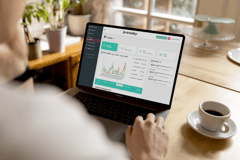Return on investment (ROI) gives a sense of direction and purpose to video marketing for retirement communities and assisted living facilities. It’s something tangible to analyze and build from. Think of it as the northern reading on your marketing team’s compass, telling you when you’re on the right path or need to readjust your course.
However, as every marketer knows, calculating the ROI isn’t always straightforward. Different tracking metrics yield different results, so it’s vital that you have a clear understanding of what your marketing efforts are trying to achieve, then build the framework to get you there. That’s why I wanted to provide a few easy tips that will help your team better understand ROI in video marketing - because using platforms with a strong ROI will drive more leads and move-ins for your senior community.
Identify Your Objectives
You wouldn’t start a road trip without a destination in mind. The same notion is true for your senior living community's video marketing strategy, where you want to begin by identifying goals. Without crystal clear goals, you won’t know what to measure for your ROI tracking. Some of the most common goals for a video marketing plan include:
- Boosting brand awareness
- Reputation management
- Qualified lead generation
- Improved conversion rates
- Educate prospects and loved ones
Once you have your goals established, then you can identify the metrics that will help you gauge your ROI. Generally, it’s usually best to choose three different metrics relevant to a goal rather than tracking every imaginable data set.
As I’ve seen many times, paralysis by analysis can easily occur if you’re trying to monitor too much information. So, as an example, if your goal is to build brand visibility, then you’ll want to zero in on metrics that measure reach, like social media traction.
Keep Your Data and Strategy Manageable
As tempting as it might be to track performance for every video, that can quickly become unmanageable, especially if you’re a large organization or particularly active with your video marketing. Instead, break down that analysis to use cases and video types. For example, you could track all of your virtual tour videos as a group to monitor traction and engagement levels to see if they’re meeting your goals.
Also, remember that video marketing – and digital marketing in general – is a collaborative effort. If you’re creating introductory videos for new members of your team, HR should be involved in setting the associated goals as well as creating the videos. The same goes for a sales team and a set of videos meant to drive more potential resident leads – marketing shouldn’t feel like they’re on their own.
Monitor Your Performance
The whole point of gauging ROI is to monitor your performance and see where you excel and where you need to improve. And to do that, you need to understand where you’re coming from, making it crucial to establish a baseline to work from.
For video marketing, that monitoring begins when you put a new video live, whether that’s posting it to social media, embedded in an email, or using another digital marketing channel. From that first moment, you need to be able to monitor and measure success relative to goals. This way, as you continue to track performance, you can change your approach as you go to maximize results.
Also, it’s important to note that if you’re using a new system, platform, or strategy - that tool may take a while to gain traction. Rarely does the first video you create break the internet and get you a 500% ROI. As you implement video marketing tools, know the data builds over time so you can tweak and improve the strategy. This is normal and healthy.
Prioritize Your Efforts
One of the most important aspects of maximized ROI is efficiency. Prioritize your attention and resources to what drives the most positive impact on your results. It’s simply not worth it to invest vast amounts of effort, time, and money into improving something that doesn’t move the ROI needle much.
For your video marketing, that means once you’ve established your goals and baseline, started tracking performance through key metrics, and identified weak points in your approach, you should focus on changes that have the most impact on reaching your goals. I've found that concentrating on the low hanging fruit, at least initially, will provide some easy wins that can quickly boost ROI and create a sense of momentum behind your video marketing strategy.
Establish Milestones to Keep You on Track
Improved metrics don’t necessarily equal success. It’s important to remember that your performance doesn’t exist in a vacuum, so establishing milestones will help you continually measure where you’re at against your overall objective.
As an example, let’s say you’re launching a new email marketing campaign. You’ve decided to use embedded videos rather than copy since 3x as many people prefer to learn about a product or service through video than text. After the third round of emails, you check the numbers and see that five more people responded to that third email than the second one. Yes, improvement is always a good thing, but if you are still 50 responses below where you need to be to reach your goal, obviously something is amiss.
However, suppose you had established milestones after each round of emails. In that case, you could have been making smaller adjustments after each round rather than suddenly dealing with a massive, 50 response discrepancy. Making minor, frequent changes is far easier than a single massive one, especially for busy teams.
Compare Apples to Apples
Lastly, when analyzing your ROI, it’s always best to compare similar data sets. For instance, comparing the metrics for a mature campaign against a newer one is likely to give you skewed results.
Naturally, a later-stage campaign should provide more robust returns than a newer one that you’re still fine-tuning. But if you’re directly comparing the two, you could easily get false performance and ROI data that might impact your decision-making process. Compare apples to apples whenever possible to avoid gauging metrics out of context.
Using these best practices, you’ll not only have a clearer view of your video marketing’s ROI, but what you can do to improve it as well. As always, OneDay is here to provide both the insights and solutions to make your video marketing a true competitive edge in a crowded senior living industry.




